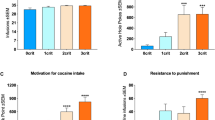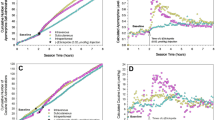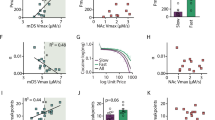Abstract
A novel behaviorally dependent dosing (BDD) schedule was used to examine the relationship between doses of cocaine self-administered by rats and brain drug levels within a session. The BDD schedule used a hold-down response to activate a syringe pump. The length of time the lever was held down determined the duration that the syringe pump was activated. In the first experiment, rats self-administered cocaine for daily 3 h sessions and brain levels of cocaine were modeled using well-established parameters. Although analysis revealed that rats self-administered doses within a predicted range, one extremely large dose was consistently observed at the beginning of each session when brain levels of cocaine were low. In the second experiment, we introduced a range of timeout periods (10–25 min) in order to produce variability in brain-cocaine concentrations. Animals self-administered larger doses immediately following each timeout period and the dose size was inversely correlated with the length of the timeout. These results show that the dose of cocaine that rats self-administer within a session is inversely related to the amount of drug on board.
Similar content being viewed by others
Log in or create a free account to read this content
Gain free access to this article, as well as selected content from this journal and more on nature.com
or
References
Ahmed SH, Koob GF (2005). Transition to drug addiction: a negative reinforcement model based on an allostatic decrease in reward function. Psychopharmacology (Berl) 180: 473–490.
Amsel A (1958). The role of frustrative nonreward in noncontinuous reward situations. Psychol Bull 55: 102–119.
Arnold JM, Roberts DC (1997). A critique of fixed and progressive ratio schedules used to examine the neural substrates of drug reinforcement. Pharmacol Biochem Behav 57: 441–447.
Bergman J, Paronis CA (2006). Measuring the reinforcing strength of abused drugs. Mol Interv 6: 273–283.
Caine SB, Koob GF (1994). Effects of mesolimbic dopamine depletion on responding maintained by cocaine and food. J Exp Anal Behav 61: 213–221.
Ettenberg A, Pettit HO, Bloom FE, Koob GF (1982). Heroin and cocaine intravenous self-administration in rats: mediation by separate neural systems. Psychopharmacology (Berl) 78: 204–209.
Hermans A, Keithley RB, Kita JM, Sombers LA, Wightman RM (2008). Dopamine detection with fast-scan cyclic voltammetry used with analog background subtraction. Anal Chem 80: 4040–4048.
Ito R, Dalley JW, Robbins TW, Everitt BJ (2002). Dopamine release in the dorsal striatum during cocaine-seeking behavior under the control of a drug-associated cue. J Neurosci 22: 6247–6253.
Johanson CE, Schuster CR (1975). A choice procedure for drug reinforcers: cocaine and methylphenidate in the rhesus monkey. J Pharmacol Exp Ther 193: 676–688.
Liu Y, Roberts DC, Morgan D (2005). Effects of extended-access self-administration and deprivation on breakpoints maintained by cocaine in rats. Psychopharmacology (Berl) 179: 644–651.
Llewellyn ME, Iglauer C, Woods JH (1976). Relative reinforcer magnitude under a nonindependent concurrent schedule of cocaine reinforcement in rhesus monkeys. J Exp Anal Behav 25: 81–91.
Lynch WJ, LaBounty LP, Carroll ME (1998). A novel paradigm to investigate regulation of drug intake in rats self-administering cocaine or heroin intravenously. Exp Clin Psychopharmacol 6: 22–31.
Morgan D, Liu Y, Oleson EB, Roberts DC (2009). Cocaine self-administration on a hold-down schedule of reinforcement in rats. Psychopharmacology (Berl) 201: 601–609.
Nicola SM, Deadwyler SA (2000). Firing rate of nucleus accumbens neurons is dopamine-dependent and reflects the timing of cocaine-seeking behavior in rats on a progressive ratio schedule of reinforcement. J Neurosci 20: 5526–5537.
Pan HT, Menacherry S, Justice Jr JB (1991). Differences in the pharmacokinetics of cocaine in naive and cocaine-experienced rats. J Neurochem 56: 1299–1306.
Peoples LL, Cavanaugh D (2003). Differential changes in signal and background firing of accumbal neurons during cocaine self-administration. J Neurophysiol 90: 993–1010.
Peoples LL, Kravitz AV, Lynch KG, Cavanaugh DJ (2007). Accumbal neurons that are activated during cocaine self-administration are spared from inhibitory effects of repeated cocaine self-administration. Neuropsychopharmacology 32: 1141–1158.
Peoples LL, Lynch KG, Lesnock J, Gangadhar N (2004). Accumbal neural responses during the initiation and maintenance of intravenous cocaine self-administration. J Neurophysiol 91: 314–323.
Pettit HO, Justice Jr JB (1991). Effect of dose on cocaine self-administration behavior and dopamine levels in the nucleus accumbens. Brain Res 539: 94–102.
Pickens R, Thompson T (1968). Cocaine-reinforced behavior in rats: effects of reinforcement magnitude and fixed-ratio size. J Pharmacol Exp Ther 161: 122–129.
Quadros IM, Miczek KA (2009). Two modes of intense cocaine bingeing: increased persistence after social defeat stress and increased rate of intake due to extended access conditions in rats. Psychopharmacology (Berl) 206: 109–120.
Ranaldi R, Pocock D, Zereik R, Wise RA (1999). Dopamine fluctuations in the nucleus accumbens during maintenance, extinction, and reinstatement of intravenous D-amphetamine self-administration. J Neurosci 19: 4102–4109.
Roberts DC, Goeders NE (1989). Drug self-administration: Experimental methods and determiants. Boalton AA, Baker GB, Greenshaw AS (eds). In: Neuromethods, vol. 13. Psychopharmacology. Humana press: Clifton, NJ. pp 349–398.
Samaha AN, Li Y, Robinson TE (2002). The rate of intravenous cocaine administration determines susceptibility to sensitization. J Neurosci 22: 3244–3250.
Shou M, Ferrario CR, Schultz KN, Robinson TE, Kennedy RT (2006). Monitoring dopamine in vivo by microdialysis sampling and on-line CE-laser-induced fluorescence. Anal Chem 78: 6717–6725.
Stafford D, LeSage MG, Glowa JR (1998). Progressive-ratio schedules of drug delivery in the analysis of drug self-administration: a review. Psychopharmacology (Berl) 139: 169–184.
Stuber GD, Roitman MF, Phillips PE, Carelli RM, Wightman RM (2005a). Rapid dopamine signaling in the nucleus accumbens during contingent and noncontingent cocaine administration. Neuropsychopharmacology 30: 853–863.
Stuber GD, Wightman RM, Carelli RM (2005b). Extinction of cocaine self-administration reveals functionally and temporally distinct dopaminergic signals in the nucleus accumbens. Neuron 46: 661–669.
Tsibulsky VL, Norman AB (1999). Satiety threshold: a quantitative model of maintained cocaine self-administration. Brain Res 839: 85–93.
Ward SJ, Morgan D, Roberts DC (2005). Comparison of the reinforcing effects of cocaine and cocaine/heroin combinations under progressive ratio and choice schedules in rats. Neuropsychopharmacology 30: 286–295.
Wilson MC, Hitomi M, Schuster CR (1971). Psychomotor stimulant self administration as a function of dosage per injection in the rhesus monkey. Psychopharmacologia 22: 271–281.
Wise RA, Newton P, Leeb K, Burnette B, Pocock D, Justice Jr JB (1995). Fluctuations in nucleus accumbens dopamine concentration during intravenous cocaine self-administration in rats. Psychopharmacology (Berl) 120: 10–20.
Zernig G, Ahmed SH, Cardinal RN, Morgan D, Acquas E, Foltin RW et al (2007). Explaining the escalation of drug use in substance dependence: models and appropriate animal laboratory tests. Pharmacology 80: 65–119.
Zimmer BA, Dobrin CV, Roberts DC (2011). The self-administered dose of cocaine predicts the subsequent inter-infusion interval. (unpublished data)
Acknowledgements
This study was supported by the NIDA research Grant R01 DA14030 (to DCSR).
Author information
Authors and Affiliations
Corresponding author
Ethics declarations
Competing interests
The authors declare no conflict of interest.
Rights and permissions
About this article
Cite this article
Zimmer, B., Dobrin, C. & Roberts, D. Brain-Cocaine Concentrations Determine the Dose Self-Administered by Rats on a Novel Behaviorally Dependent Dosing Schedule. Neuropsychopharmacol 36, 2741–2749 (2011). https://doi.org/10.1038/npp.2011.165
Received:
Revised:
Accepted:
Published:
Issue date:
DOI: https://doi.org/10.1038/npp.2011.165
Keywords
This article is cited by
-
Intermittent nicotine access is as effective as continuous access in promoting nicotine seeking and taking in rats
Psychopharmacology (2024)
-
Prelimbic and infralimbic medial prefrontal cortex neuron activity signals cocaine seeking variables across multiple timescales
Psychopharmacology (2023)
-
D-amphetamine maintenance therapy reduces cocaine use in female rats
Psychopharmacology (2022)
-
Amphetamine maintenance therapy during intermittent cocaine self-administration in rats attenuates psychomotor and dopamine sensitization and reduces addiction-like behavior
Neuropsychopharmacology (2021)
-
Effects of Kappa opioid receptor blockade by LY2444296 HCl, a selective short-acting antagonist, during chronic extended access cocaine self-administration and re-exposure in rat
Psychopharmacology (2020)



